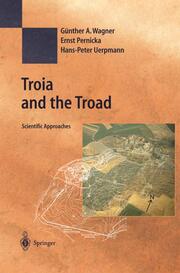-
Zusatztext
-
It is my pleasure to welcome you here on the occasion of the International Symposium, "Landscape Troia between Earth History and Culture". The topic Troia has stimulated many scientists, historians and experts in the history of arts to interpret data and adjust concepts regarding the de velopment of early Troia. In the past two decades the Heidelberg Academy of Sciences and Humanities has supported several research activities which are related to the Troia project. One of the aims of the archaeometry laboratory is to localize Aegean and Anatolian sources for the procurement of prehistoric metals such as gold, silver, lead, copper and tin. In particular in the Troad, numerous mining and smelting sites have been found and characterized, allowing one to investigate to which extent they might have been exploited by the acient Troians. When analytically comparing ores and slags with Troian metal artifacts, early trade connections can be traced. The landscape around Troia underwent rather fast and drastic changes.
-
-
Kurztext
-
When reconstructing the past, the archaeologist needs to take into account all kinds of relevant information. Where no written sources are available, the natural sciences play an indispensable role. Troia is a remarkable site in this respect. The present excavation project at Troia, under the directorship of Manfred Korfmann, integrates various disciplines including geoarchaeology, archaeobotany, zooarchaeology, anthropology, geophysical prospection as well as chemical and technological studies of metal, stone and pottery. Hardly any other archaeological project is supported so intensely and on such a broad scale by archaeometric investigations as the international research group in Troia. In April 2001 an International Symposium was held in Heidelberg, Germany, with the aim of promoting scientific discussion and providing synopses of the various disciplines engaged in Troia. This volume contains most of the contributions presented at the symposium. Due to its broad natural scientific as well as its cultural-historic scope, not only will the specialist but also the interested layman find the book rewarding.
-
-
Autorenportrait
- Inhaltsangabe1 Introduction - Troia and Natural Sciences.- Historical and Geological Context of the Troad.- 2 The Case for Historical Significance in Homer's Landmarks at Troia.- 3 The Relationship Between Man and Landscape in the Troad During the Ottoman Period.- 4 Heidelberg Radiocarbon Dates for Troia I to VIII and Kumtepe.- 5 Seismotectonics and Geology of Troia and Surrounding Areas, Northwest Anatolia.- 6 The Link Between the Black Sea and the Mediterranean Since the End of the Last Ice Age: Archaeology and Geology.- 7 On the Oscillations of the Black Sea Level in the Holocene Period from an Archaeological Viewpoint.- 8 The Black Sea, the Sea of Marmara and Bronze Age Archaeology - an Archaeological Predicament.- 9 Delta Evolution and Culture - Aspects of Geoarchaeological Research in Miletos and Priene.- Mineral Deposits and Materials.- 10 Early Bronze Age Metallurgy in the Northeast Aegean.- 11 On the Composition and Provenance of Metal Finds from Besiktepe (Troia).- 12 Provenance of White Marble Building Stones in the Monuments of Ancient Troia.- 13 Provenance Studies of Pottery and Granite Columns in Troia.- 14 On the Origin of Coarse Wares of Troia VII.- Archaeobiology.- 15 Environmental Aspects of Economic Changes in Troia.- 16 Troia and Fallow Deer.- 17 Troian Bird Remains - Environment and Hunting.- 18 Proposal of an Effective Concept for the Troad - a Strategy for the Preservation of an Important Ecological Building Block in the International System of Bird Migration.- 19 Rural Plenty: the Result of Hard Work - Rich Middle Bronze Age Plant Remains from Agios Mamas, Chalkidike.- 20 Regional Palaeodemographic Aspects of Troia and Its Ecosystem.- Landscape Change of the Trojan Site and Plain.- 21 Some Open Questions About the Plain of Troia.- 22 The Geophysical Mapping of the Lower City of Troia/Ilion.- 23 Stratigraphy, Geochemistry and Geochronometry of Sedimentary Archives Around Hisarhk Hill - a Pilot Study.- 24 Sedimentary Facies Patterns and the Interpretation of Paleogeographies of Ancient Troia.- 25 Geoarchaeological Interpretations of the "Troian Bay".- References.
Detailansicht
Troia and the Troad
Scientific Approaches, Natural Science in Archaeology
ISBN/EAN: 9783642078323
Umbreit-Nr.: 1538164
Sprache:
Englisch
Umfang: xvi, 449 S., 155 s/w Illustr., 3 farbige Illustr.,
Format in cm:
Einband:
kartoniertes Buch
Erschienen am 10.04.2011
Auflage: 1/2003


